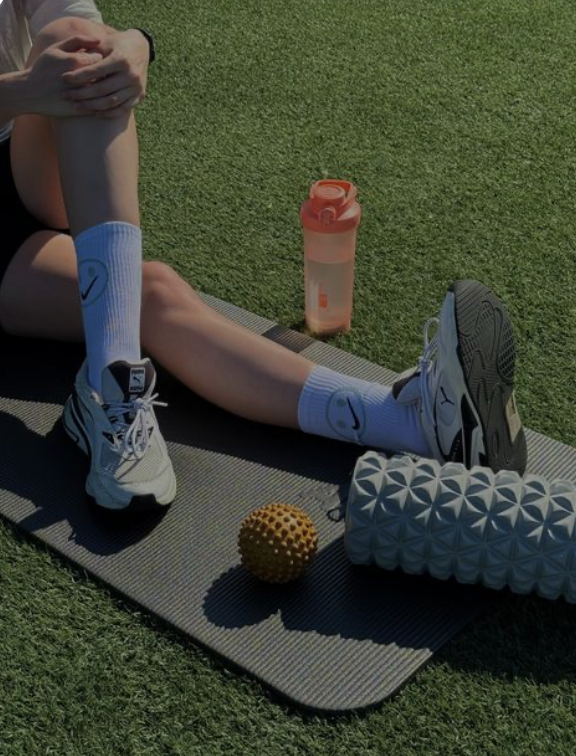You’ve probably heard it before that rest days are important. Whether your goal at the gym is to build muscle, lose weight or simply maintain general health and fitness, recovery is a nonnegotiable. Recovery is the process of returning to a normal state of health, mind or strength, which is necessary not only after strength training but also after a long day filled with various sources of stress.
In short, strength training creates microtears in our muscle fibres, and during recovery, our muscles must rebuild themselves to come back stronger than before. Recovery can be passive or active; including both forms is key to meeting your body’s needs. Without rest and recovery, not even the best training program will deliver results.
Passive recovery
Passive recovery refers to the lifestyle habits that support muscle recovery, but do not directly engage the fatigued muscles. These habits include maintaining good nutrition quality, prioritizing sleep hygiene, and managing stress levels. If these sound familiar, it’s because these habits closely align with the 8 Rocks of Health. Focusing on these aspects of health is the key to performing at your best, both inside and outside of the gym.
Pre and post workout fuel
Pre and post-workout fuel is crucial, as it not only gives you enough energy to push yourself during your workout but also aids in muscle recovery after the session.
Carbohydrates provide our muscles with energy (aka glycogen) during our workouts, and even something as small as a piece of fruit or toast can help keep our energy levels stable throughout our workout. After training, we should be focused on including a combination of protein and carbohydrates to support muscle repair and refill our glycogen stores. We should be aiming for around 20-30g of protein in our post-workout meal.
Finding the right meal timing is crucial, and it largely depends on the size of your pre-workout meal. As a general guideline, aim to eat 30-60 minutes before and after your workout. With that being said, listen to your body and adjust based on how you feel during your workout.
Hydration is the last piece of the puzzle. It is essential to hydrate before, after, and during exercise. Consider adding electrolytes, especially during extra sweaty or intense sessions, to replenish lost electrolyte stores.
Sleep hygiene
Sleep is the foundation of recovery. During deep sleep, our bodies release human growth hormone (HGH). HGH is responsible for muscle recovery, enabling us to build stronger muscles. Simply put, our body cannot efficiently recover without adequate rest. Sleep hygiene is a term that refers not only to the amount of sleep we get each night but also to the quality of our sleep. Creating a consistent sleep and wake schedule, reducing blue light exposure, and exercising regularly are all ways to support a good night’s rest. Not to mention, sleep plays a crucial role in our stress management, energy levels, and immune function, all of which significantly impact our performance at the gym.
Stress management
Lastly, managing stress is an essential part of passive recovery. Chronic stress leads to higher levels of cortisol, which impairs our body’s ability to repair our muscles. High levels of cortisol also lead to disruptions in our sleep patterns, which negatively impact our sleep hygiene and create a cycle of fatigue. Finding effective stress management techniques is highly individual, whether that includes meditation, breath work, spending time outdoors or connecting with loved ones, seeing what works best for you is key.
Active recovery
Active recovery refers to low-intensity activities that boost circulation and help to deliver oxygen and nutrients to the muscles. The increase in blood flow promotes muscle repair and reduces soreness without fatiguing the muscles.
Activities such as easy walking, yoga, swimming, cycling, static stretching and dynamic stretching can all be examples of active recovery when performed at a low intensity. Another benefit of active recovery is that it helps to reduce muscle soreness while improving mobility and movement quality.
Other ways to help reduce muscle soreness include foam rolling, massage, or heat therapy, however these are considered passive recovery These methods promote blood flow to our muscles, and they are most effective when used in addition to the other recovery modalities for even greater benefit.
The best way to prioritize recovery is to build it into your lifestyle. A well-rounded approach with proper nutrition, sleep, daily movement, and effective stress management supports both active and passive recovery.
When we prioritize our recovery, we perform better, feel stronger, and reduce our risk of injury while setting ourselves up for long-term success in our health and fitness journey.
Nutrition is a cornerstone of health and wellness. The foods we select energize our bodies for daily activity, recovery, and sustained vitality. More than just eating the right amount, choosing high-quality, nutrient-dense foods is essential for achieving a longer and better quality of life.
We recognize that diet and nutrition can seem daunting. There is an abundance of fad diets and conflicting media messages. Yet, nutrition quality does not have to be complex. In fact, going back to the basics and focusing on whole, minimally processed foods can help to create a more nutrient-dense diet. Let’s explore three essential components of nutrition quality: macronutrients, gut health and micronutrients.


